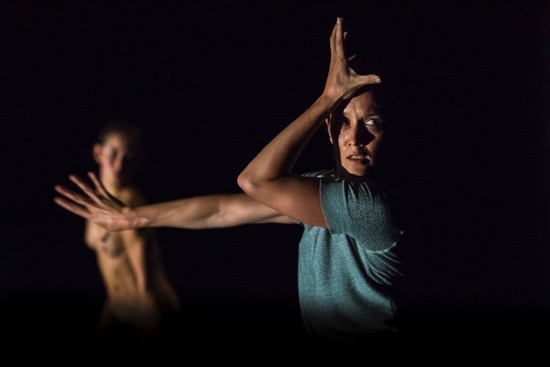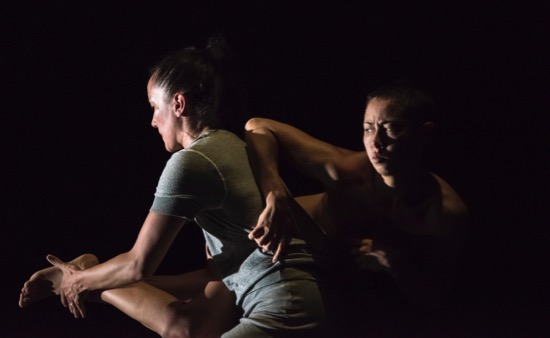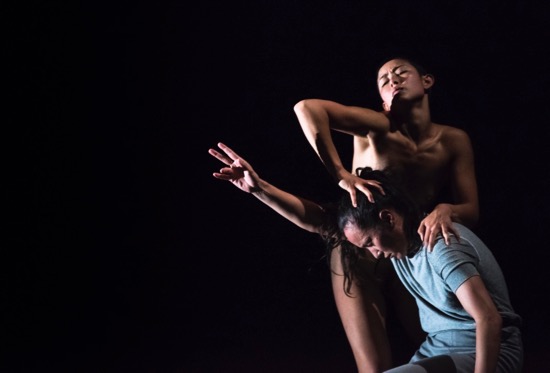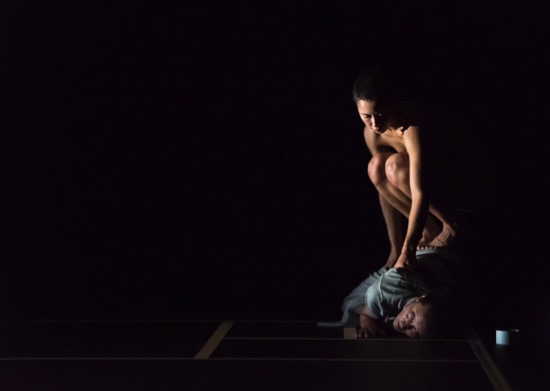Lucy Guerin Inc performs Guerin’s Split at the Baryshnikov Arts Center, October 13 through 15.

Lilian Steiner (L) and Melanie Lane in Lucy Guerin’s Split. Photo: Gregory Lorenzutti
Some European and American choreographers focus primarily on illuminating music, creating light-hearted romps, or re-envisioning beauty and nobility in tragedy (think Giselle, think Odette). However, impelled in part by Martha Graham, Doris Humphrey, and their contemporaries, others have probed onto the stage some of our more barbaric instincts, letting rage or fear shape dancing.
This thought slithered into my mind after I saw Lucy Guerin’s fierce and astonishing Split at the Baryshnikov Arts Center. Some New York dancegoers will remember Guerin as a performer in works by Tere O’Connor, Bebe Miller, and Sara Rudner between 1989 and 1996, before she returned to her native Australia and began to concentrate on her own choreography (numerous awards and commissions have come her way since then).
Guerin made Split in 2017. You can connect its title to the way in which she structured this duet, or perhaps conceive it as a study of split personality. The dark floor of BAC’s Jerome Robbins Theater has been outlined in white tape, and, over the course of the piece, two champion dancers, Melanie Lane and Lilian Steiner (both choreographers themselves), divide it by laying down another line of tape between the back of the stage floor and its front, then later divide one half of that horizontally, and, finally, create a rectangle within that. As the space in which they perform gradually shrinks to the size of a doormat, the amount of time they spend in each of its incarnations shrinks too. The score by Scanner (Robin Rimbaud), in a sound design by Robin Fox, begins with muffled percussive rhythms, becoming strident or falling silent as the piece develops.

Melanie Lane (in blue) and Lilian Steiner in Lucy Guerin’s Split. Photo: Gregory Lorenzutti.
The most startling thing about Split is that Lane wears a loose-fitting dress in a silky blue material, while Steiner is naked, although they begin more or less side by side, dancing in perfect synchrony. Their moves are precise, whether they swing their arms, twist their bodies, yank a shoulder, jump in place, or keep bending, getting closer to the ground each time, until they’re almost squatting. No gestures are sustained at this point, and some of these can remind us of an action we know: digging into an invisible surface, lifting a wrist as if to pour tea or say “see my bracelet?” But there is no “acting” involved in the doing of these.
As the patterns become more energetic, larger in scale, and Steiner and Lane begin to travel around the space, you start to notice how motion and costume affect your perception of the women. Lane’s dress conceals her thighs and part of her upper arms; her movements cause the dress to swirl around her as she spins, and it quivers into place when she lands from a leap. Steiner’s body is like an unsheathed knife. It offers no distraction. Nothing veils the muscles of her back, the hinging of her thighs to her pelvis. Too, her hair is twisted into a bun, while Lane’s voluminous mane is gathered into a ponytail, until, at some revealing moment, she lets it down to churn loose around her.

Lilian Steiner forcing Melanie Lane to the floor. Photo: Gregory Lorenzutti
The subtle music and Paul Lim’s lighting alter in response to changes in the space and atmosphere—sometimes bright or loud, sometimes dimmer and quieter. Halfway through the first section, the two dancers drop to the floor; they sit for a while, recline, lie. Their gestures become more personal; one woman strokes her thigh, the other her cheek. Their movements appear more angular, staccato, but you also begin to see suspended moments and little fidgety steps among the music’s rhythms.
Once the first length of white tape has been unrolled, placed, and smoothed down, Steiner watches while Lane licks her finger and launches into an extraordinary fit of shaking and pushing at the air. The formality of the first unison section has vanished. Steiner’s response to this first looks like entreaty, but turns into ferocity. She pulls on Lane’s face. Lane holds her by the arm and lashes her around. While Lane is dancing, Steiner creeps up behind her like a cat and grabs her. The women don’t “react” to the state of war that their moves convey—not even when Steiner, with cool deliberation, sticks a finger into Lane’s mouth or Lane strokes the sole of Steiner’s raised foot.

Lucy Guerin’s Split. Lilian Steiner crouching on Melanie Lane. Photo: Gregory Lorenzutti
In the next decrease of space, these extremely gifted dancers move differently, as if affirming their individuality under difficult circumstances, while drawing from the same vocabulary of steps. But when their area becomes still smaller and darker, they start to twist around each other in ways that appear conflicted, even punitive. Lane crawls with Steiner on her back. Even though the two are matter-of-fact and cooperative in laying out the tapes that define each new environment, you sense animosity once the task is completed; Steiner becomes more feral, her gaze intense, her body primed. When Lane huddles on the floor, her companion/adversary squats on her back and stares toward us. Split is almost done. The lights go dark on an unresolved image. Has either of the two “won?” Or was that no longer an issue? In the tiny remaining space, they have to co-exist. Or re-conceive their world. Think about it.

Fierce and astonishing, indeed. Or in a more classical aspect, generating pity and terror.
As I watched the diminutions of their space progress, I had thoughts of scarcity of resources and restraints on freedom, and their adverse impacts on our animal beings and behavior. The powerful resonance of this work was truly startling and revelatory.
Thank you for your review.